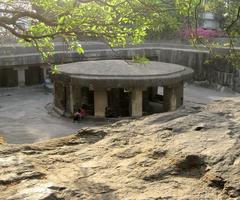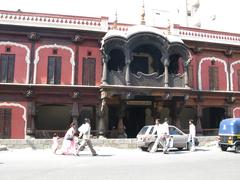Visiting Omkareshwar Mandir in Pune: History, Tips, and Visitor Information
Date: 18/07/2024
Discover the rich history and cultural significance of Omkareshwar Mandir in Pune. This guide provides all the essential information for visitors.
Welcome to the Omkareshwar Mandir, a magnificent testament to resilience and architectural grandeur, situated on the banks of the Mutha River in Pune. This guide will navigate you through its rich history, architectural significance, and practical visitor information. Whether you’re a history enthusiast, a spiritual seeker, or a curious traveler, Omkareshwar Mandir offers a captivating glimpse into India’s cultural tapestry. The temple’s origins date back to the 18th century, under the patronage of Chimaji Khanderao Peshwa, and it stands as a symbol of Maratha pride and devotion (Pune Government). The temple is not just a place of worship but also a historical monument, having witnessed the rise and fall of empires, floods, and the Indian independence movement. Its unique blend of Maratha, Mughal, and Rajput architectural styles makes it a visual and cultural marvel.
Table of Contents
- Introduction
- History and Architectural Significance
- Visitor Information
- Special Events and Guided Tours
- FAQ
- Conclusion
Introduction
Welcome to the Omkareshwar Mandir, a magnificent testament to resilience and architectural grandeur, situated on the banks of the Mutha River in Pune. This article will guide you through its rich history, architectural significance, and provide essential visitor information, including visiting hours, ticket prices, and travel tips. Whether you’re a history enthusiast or a curious traveler, the Omkareshwar Mandir offers a captivating glimpse into India’s cultural tapestry.
History and Architectural Significance
The Omkareshwar Mandir’s history is intertwined with the rise and fall of empires, adding a layer of intrigue to its captivating presence.
The Peshwa Legacy
The temple’s origins can be traced back to the 18th century, a period when the Maratha Confederacy held sway over much of India. The visionary behind this architectural marvel was Chimaji Khanderao Peshwa, the younger brother and a distinguished military commander under the renowned Peshwa Bajirao I. (Pune Government)
Chimaji, a devout follower of Lord Shiva, undertook the temple’s construction in 1749 as an offering of gratitude for his brother’s victories against the Mughals. The temple, dedicated to Lord Shiva in his form as Omkareshwar (the ‘Lord of the Om Sound’), became a symbol of Maratha pride and devotion.
Architectural Splendor - A Fusion of Styles
The Omkareshwar Mandir stands as a magnificent example of Maratha architecture, seamlessly blending elements of Mughal and Rajput styles. This fusion is evident in the temple’s intricate carvings, majestic domes, and expansive courtyards, reflecting the diverse cultural influences prevalent during the era.
Key Architectural Features
-
Black Stone Structure: The temple, predominantly built from black stone, stands out against the backdrop of the city. This unique choice of material not only adds to its visual appeal but also reflects the region’s geology.
-
Elevated Platform: Situated on a raised platform, the temple commands a prominent position overlooking the Mutha River. This elevation, a common feature in temple architecture, signifies a sacred space separated from the mundane.
-
Garbhagriha (Sanctum Sanctorum): The inner sanctum houses the Shiva Linga, the symbolic representation of Lord Shiva. This sacred space, accessible only to priests, forms the heart of the temple.
-
Sabha Mandap (Assembly Hall): Supported by intricately carved pillars, the Sabha Mandap served as a space for religious gatherings and ceremonies. The hall’s design allows for natural light and ventilation, creating an airy and serene ambiance.
-
Nagarkhana (Drum Chamber): Located above the main entrance, the Nagarkhana housed musicians who played traditional instruments during religious festivals and processions.
-
Surrounding Shrines: The main temple complex encompasses smaller shrines dedicated to various Hindu deities, including Lord Ganesha, Goddess Parvati, and Lord Vishnu. This reflects the inclusive nature of Hinduism, where different deities are seen as manifestations of the one Supreme Being.
Enduring the Test of Time
The Omkareshwar Mandir has witnessed significant historical events since its inception. From the decline of the Maratha empire to the rise of British colonialism, the temple remained a steadfast symbol of faith and resilience.
-
Floods and Restoration: The temple’s location on the banks of the Mutha River, while picturesque, also made it vulnerable to floods. Over the centuries, the temple faced several floods, causing damage to its structure. However, each time, the temple was painstakingly restored by devotees, reflecting their unwavering commitment to preserving their heritage.
-
Symbol of Resistance: During the Indian independence movement, the Omkareshwar Mandir served as a meeting point for freedom fighters. Its historical significance and cultural importance made it a rallying point for those seeking to overthrow British rule.
Visitor Information
Planning a visit to the Omkareshwar Mandir? Here are some essential details to help you prepare:
- Visiting Hours: The temple is open to visitors from 6:00 AM to 10:00 PM daily.
- Ticket Prices: Entry to the temple is free for all visitors.
- Travel Tips: The best time to visit is during the early morning or late evening to avoid the crowds and enjoy the serene atmosphere. Wearing comfortable footwear is recommended as you may need to walk on uneven surfaces.
- Nearby Attractions: While in Pune, you can also explore nearby historical sites such as Shaniwar Wada, Aga Khan Palace, and the Pataleshwar Cave Temple.
- Accessibility: The temple is accessible to visitors of all ages. However, the elevated platform and steps may pose challenges for those with mobility issues.
Special Events and Guided Tours
The Omkareshwar Mandir hosts various religious festivals and special events throughout the year. Guided tours are available for those interested in learning more about the temple’s history and architectural significance. Check the official website or contact the temple administration for the latest information on upcoming events and tours.
FAQ
Q: What are the visiting hours for Omkareshwar Mandir?
A: The temple is open from 6:00 AM to 10:00 PM daily.
Q: Is there an entry fee for Omkareshwar Mandir?
A: No, entry to the temple is free for all visitors.
Q: What are some nearby attractions to Omkareshwar Mandir?
A: Nearby attractions include Shaniwar Wada, Aga Khan Palace, and the Pataleshwar Cave Temple.
Q: Are guided tours available at Omkareshwar Mandir?
A: Yes, guided tours are available. Check the official website or contact the temple administration for more details.
Conclusion
The Omkareshwar Mandir stands as a testament to the architectural prowess and religious fervor of the Maratha era. It is not merely a historical monument but a living testament to faith, attracting devotees and tourists alike. The temple’s serene atmosphere, intricate carvings, and historical significance offer a glimpse into India’s rich cultural tapestry. Plan your visit today and immerse yourself in the spiritual and historical essence of this remarkable site.
References
- Pune Government (2024) pune.gov.in




